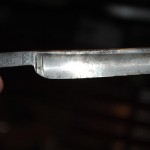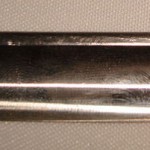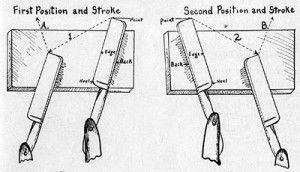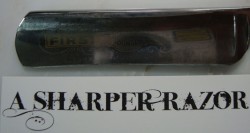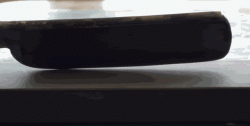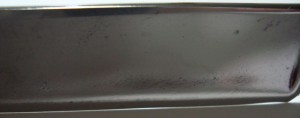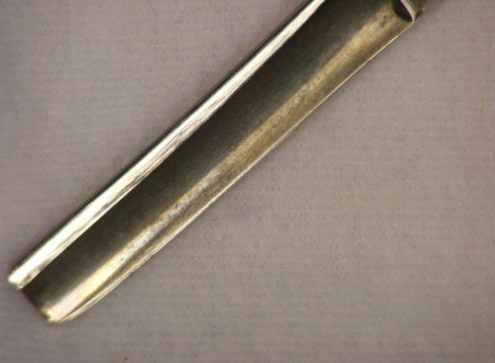
This poor razor has come to an early end due to poor honing technique
Sharpening a straight razor is no easy task. It takes skill, time, and patience. Not to mention the correct equipment. Otherwise, you end up with something like the razor pictured above. Unfortunately, it gets a lot worse. Sad, but true. So, let’s just dive in and talk about the worst honing mistakes and how they severely shorten your razor’s useful lifespan.
Excessive Toe Wear
The toe is the tip of the razor. The heel is then, the back part of the razor where the bolster is. Excessive toe wear is by far the most common honing mistake in thousands of vintage razors. Sometimes, the toe wear was intentional. In other cases, the toe wear was a result of improper sharpening technique. Let’s take a look at some examples.
As you can see, the razor’s tip, or toe, has been sharpened more often than the rest of the razor. In other words, it shows more wear & tear. The underlying problem is just that: the toe has been sharpened more than the rest of the razor. Stated in another way, the toe has spent more time on the sharpening stone than the rest of the razor.
Compounding this problem is the use of a lower grit stone than necessary. In many cases, barbers would use barber stones to re-sharpen their straight razors for their clients. These stones were not of as fine a grit as is available today. Consequently, they took off a lot of steel. More steel than necessary. Thus, the razors would be prematurely ground down to a useless level.
The toe is subjected to additional wear & tear for two reasons: 1) the user uses the toe of the razor far more often than the rest of the razor and consequently sharpens it more often; and 2) the sharpener does not have the requisite skill level to properly sharpen the straight razor.
Let’s talk about #1 first. While you may think this is not a huge problem, it is still a mistake. Not only in the honing, but also in the usage of the straight razor. Care should be taken to utilize the entirety of the blade when shaving. You should not be using only one part of the straight razor. There is a reason the straight razor is typically three inches in length. In addition, even if you did use the toe more often than any other portion of the straight razor, there is no reason you should be using it so much that the rest of the razor remains completely sharp while the toe dulls. No practical usage will do that to a straight razor. No, the reason the toe receives so much wear is improper honing technique. Which brings us to reason #2.
Sharpening a straight razor is a trial and error process. The amount of trial & errors necessary to become truly skilled is immense. Perhaps thousands of hours is required. Even sharpening your own straight razor can take hundreds of hours to master. And each straight razor is different, having a different curvature, feel, and weight.
The reason the toe receives more wear than the heel is because the sharpener failed to keep the straight razor level. This is actually very difficult. Yet, another reason why you need absolutely steady hands. The tendency is to lift the heel up as the straight razor is sharpened, concentrating pressure on the toe. Another reason is that as the razor is dragged across the stone, the heel only spends a short amount of time on the stone, the middle portion a little more, and the toe spends a great deal of time. This can be seen if you look at a typical X-pattern. If you drag the razor entirely across the entire face of the hone, the toe receives a disproportionate amount of time being sharpened. Consequently, the tip is over-sharpened.
The Frown
The frowning razor is the second most common honing mistake. The frown is not only unhappy, but it slowly creeps up on the straight razor, making it more and more useless. The problem with the frowning razor is twofold: 1) the razor is extremely difficult to shave with, being pointed towards the toe and heel, and having little to no contact with your face in the middle; and 2) the razor is extremely difficult to sharpen for the same reason.
Take a look at this razor with a fairly pronounced frown.
This is actually pretty bad. Take a look at the spine wear (the wear on the spine from repeated sharpenings). This razor shows signs of being honed thousands of times. Yet, the toe and heel only show very light hone wear, meaning this razor has probably only seen maybe 20 years of service, yet is showing a whole lifetime of service in the middle. I can remove a slight frown of 1/16″ deflection at the deepest point, but this razor is going to take a lot of work. Its still possible to save it, but the money I would charge to do so makes the project a bad value.
Take a look at this similar razor with yet another pronounced frown.
 You can see the same pattern. In this picture though, you can really see the spine wear. You see that flat area at the top, that is caused by sharpening the razor. Metal on both the spine and edge are removed while sharpening. Excessive wear in the middle. This razor is a little different because it has moderate wear at the toe and almost none showing at the heel. Let’s take a look at one more.
You can see the same pattern. In this picture though, you can really see the spine wear. You see that flat area at the top, that is caused by sharpening the razor. Metal on both the spine and edge are removed while sharpening. Excessive wear in the middle. This razor is a little different because it has moderate wear at the toe and almost none showing at the heel. Let’s take a look at one more.

This razor is not as bad as the previous two. You can still see evidence of spine wear and the razor’s relative age, but the frown is not as bad. This frown is correctable. The deflection appears to be under 1/16″ at the deepest point. Our edge repair service should be able to turn this razor back into a shaving machine.
Causes
The frown is caused by excessive sharpening of the middle of the razor and not enough on the toe or heel of the razor. There are several possible culprits. One possible cause is the incorrect use of a narrow hone. If the sharpener uses a narrow stone, it extremely easy to forget about sharpening the toe or heel of the razor. Instead, the amateur razor sharpener concentrates all sharpening efforts on the middle of the razor, forgetting about the heel or toe.
Another possible cause is uneven pressure. What happens is that the sharpener started honing lightly, then as they dragged the razor across the stone, increased the pressure in the middle, and then lightened up again towards the end. Very similar to how excessive toe wear is formed, but the pressure is eased up on the end.
Yet another possible culprit is not enough time on the stone. This happens if one starts honing with the heel off of or almost off of the stone and immediately drags the heel of of the hone, and at the same time also ends the stroke early. Ending the stroke early means the toe isn’t sharpened as much.
As you can see, these problems are compounded by the fact that the middle will become sharper much quicker than the toe or heel. This further induces the amateur sharpener to continue sharpening and further exacerbating the problem. He will try to compensate for the lack of sharpness by doing more laps and removing more metal. While the toe and heel will eventually become sharp, the sharpness comes at the expense of lost metal in the middle.
The next honing mistake is a unique combination of two frowns.
The Wavy Edge
An odd name to call a honing mistake, but there really is no other way to describe it. The edge is wavy. Essentially, what happened is that the sharpener managed to add two frowns or a frown and excessive toe wear to his razor. Let’s take a look.

 As you can see from the two examples, the wavy razor is just that. Wavy. The top picture shows a frown combine with a toe that curves upwards. You can see the tell-tale signs of excessive toe wear on the spine and in the way the edge curves upward. The second picture shows you a frown in the middle hidden by what appears to be a slightly smiling razor.
As you can see from the two examples, the wavy razor is just that. Wavy. The top picture shows a frown combine with a toe that curves upwards. You can see the tell-tale signs of excessive toe wear on the spine and in the way the edge curves upward. The second picture shows you a frown in the middle hidden by what appears to be a slightly smiling razor.
In the first example, the end result is caused by simply combining excessive toe wear with a frown. In the second example, you think that the razor is smiling, but in fact, the razor has a frown in between the smile. This is actually quite common because honing a smiling razor is extremely difficult and many people try and fail to hone them properly.
Let’s take a look at a double frown.
As you can see, this razor has two frowns. This is extremely rare and I actually don’t have my own example so I had to borrow one from coticule.be to illustrate the honing mistake. Click the picture to see an animation displaying the two frowns. This is caused from poor honing technique. This probably happened because the razor has/had a slight smile in the beginning. Over time innumerable honing mistakes caused two frowns to be formed. Another possibility is that this was caused by using a narrow hone and sharpening the razor in sections. The cure is to learn to hone properly. Double frowns are so extremely rare that here really isn’t much more I can say on the matter.
Straight Edge on a Smiling Razor
Some razors are meant to be curved. Other razors are meant to be straight, but people put a smile on them. While this isn’t bad per se, you are putting unnecessary wear & tear on the razor and making it do something it wasn’t designed to do in the first place. The honing mistake is when someone hones a smiling straight razor the same way as a straight edge. Even worse is when they make it into a frown! Check out the pictures below (they actually show a smiling razor with a frown being corrected, but they illustrate the point nicely).
The straight edge on a smiling razor is a problem because it defies the natural curvature of the razor. If you try to sharpen the razor like a straight edged razor, you will end up with a frown. Perhaps the razor will go straight first and then start frowning, but the end result is the same. You get picture #2.
The reason is simple. The curvature of the spine causes the middle of the edge to touch the hone more often than the rest of the razor. Consequently, if you hone the blade normally, you will remove more metal from the middle and very little from the edges. Compound this problem with the exacerbation of not being able to get the toe and heel sharp, and you have excessive honing of the middle. This quickly becomes a frown as you continually remove metal in the middle trying to get the toe and heel sharp.
Excessive Heel Wear
This is the last example. Take a look at the picture illustrating the problem. Notice a frown in the heel? You can also see another small frown just left of the heel as well. Click the image to enlarge it and you’ll also notice that the toe of the razor is exhibiting much more hone wear than the heel. Clearly this razor is suffering from a number of problems, but let’s concentrate on the heel wear. As you can see, the heel was sharpened a lot. In fact, the heel would be ground away into a smirk if not for the bolster that got in the way. In addition, that frown just to the left is not looking good.
How the heel happened is simple. The person sharpening the razor couldn’t get the heel sharp enough to his liking and just sharpened the small area constantly until it was sharp enough for him. The bolster got in the way and he created a small frown or dent in the edge. What he should have done was ignore the bolster. In some cases it is just not possible or practical to make 100% of the edge shave ready. This is one of those cases. The bolster is just that, a bolster. It is not meant to be sharp. It’s there to protect you. Just like the bolster on forged kitchen knives.
Conclusion
There are a few more honing errors visible on many razors on ebay. Most of them involve honing a razor beyond its useful lifespan or trying to hone the bolster, but failing. But these are the top four.
To get your razor professionally sharpened and avoid any of these errors, go to our services page.

